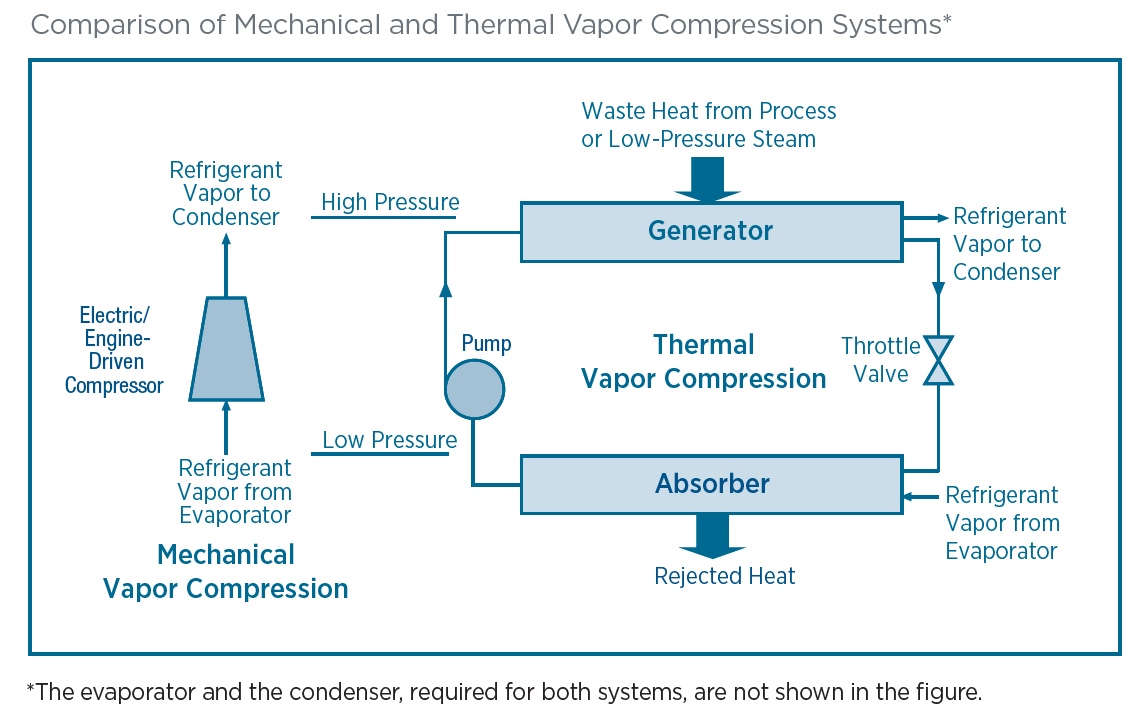 Compared to mechanical chillers, absorption chillers have a low coefficient of performance (COP = chiller load/heat input). Nonetheless, they can substantially reduce operating costs because they are energized by low-grade waste heat, while vapor compression chillers must be motor- or engine-driven.
Low-pressure, steam-driven absorption chillers are available in capacities ranging from 100 to 1,500 tons. Absorption chillers come in two commercially available designs: single-effect and double-effect. Single-effect machines provide a thermal COP of 0.7 and require about 18 pounds of 15-pounds-per-square-inch-gauge (psig) steam per ton-hour of cooling. Double-effect machines are about 40% more efficient, but require a higher grade of thermal input, using about 10 pounds of 100- to 150-psig steam per ton-hour.
Example
In a plant where low-pressure steam is currently being exhausted to the atmosphere, a mechanical chiller with a COP of 4.0 is used 4,000 hours per year (hr/ yr) to produce an average of 300 tons of refrigeration. The cost of electricity at the plant is $0.06 per kilowatt-hour (kWh).
An absorption unit requiring 5,400 pounds per hour of 15-psig steam could replace the mechanical chiller, providing annual electrical cost savings of:
Compared to mechanical chillers, absorption chillers have a low coefficient of performance (COP = chiller load/heat input). Nonetheless, they can substantially reduce operating costs because they are energized by low-grade waste heat, while vapor compression chillers must be motor- or engine-driven.
Low-pressure, steam-driven absorption chillers are available in capacities ranging from 100 to 1,500 tons. Absorption chillers come in two commercially available designs: single-effect and double-effect. Single-effect machines provide a thermal COP of 0.7 and require about 18 pounds of 15-pounds-per-square-inch-gauge (psig) steam per ton-hour of cooling. Double-effect machines are about 40% more efficient, but require a higher grade of thermal input, using about 10 pounds of 100- to 150-psig steam per ton-hour.
Example
In a plant where low-pressure steam is currently being exhausted to the atmosphere, a mechanical chiller with a COP of 4.0 is used 4,000 hours per year (hr/ yr) to produce an average of 300 tons of refrigeration. The cost of electricity at the plant is $0.06 per kilowatt-hour (kWh).
An absorption unit requiring 5,400 pounds per hour of 15-psig steam could replace the mechanical chiller, providing annual electrical cost savings of:
- 300 tons x (12,000 Btu/ton / 4.0) x 4,000 hr/yr
- x $0.06/kWh / 3,413 Btu
- = $63,287 in Annual Savings
Steam Tip 14: Use Low-Grade Waste Steam to Power Absorption Chillers
